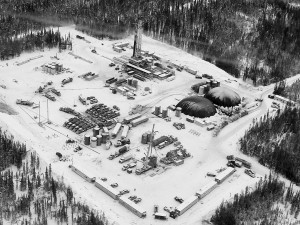Apache leads way to new natural gas trend
Company teams with service providers to power hydraulic fracturing using natural gas.
Apache has long been a proponent of expanding America’s use of natural gas, perhaps most publicly by supporting compressed natural gas (CNG) vehicles.
The same driving forces that have pushed Apache to lead the way to increase the use of natural gas – which is cheap, clean and abundant – on the nation’s roads have driven the company to kick start a new trend in the field that has the potential to save the United States millions of barrels of imported oil and significantly cut fuel costs.
Apache has partnered with Halliburton and Schlumberger to find ways to use natural gas to power hydraulic fracturing, which is one of the most energy-intensive processes employed by the industry. Currently, only one per cent of drilling rigs and zero full frac spreads are powered by natural gas.
“When I approached Halliburton and told them Apache wanted to do this, they told me that the reason that frac spreads that moved every week did not run on natural gas was due to the complexity of the natural gas supply and support infrastructure,” said Mike Bahorich, Apache’s executive vice president of Technology. “I also contacted Schlumberger. It didn’t take long for both companies to call back and tell me it could be done.”
Halliburton told Bahorich it invented a system for Apache that quickly connect natural gas to pumping engines, making natural gas a viable fuel to rapidly and routinely move from job to job. It is comprised of a simple gas line that connects from the natural gas source to an engine using a quick-connect jumper to link the natural gas line between trucks.
Bahorich decided to put out a bid to both Halliburton and Schlumberger. Each came back and said separately they would do a trial with Apache at zero cost.
“That’s almost unheard of, and it shows you how much they wanted to do this,” Bahorich said.
The reason why is clear.
In 2012, the industry will use more than 700 million gallons of diesel to pump sand and water during fracture stimulation. At an average cost of $3.40 per gallon (current U.S. average), that’s $2.38 billion spent on diesel. By converting the process to using field gas, fuel costs would be reduced by approximately 70 per cent, or by $1.67 billion.
“By using field gas, the United States would import 17 million fewer barrels of oil each year to make the diesel to fuel these fracs,” Bahorich said.
Schlumberger is testing a system using CNG while Halliburton is using liquefied natural gas (LNG). Both companies have the goal of using field gas to power the massive engines used to pump sand and water into the ground to fracture the earth and release hydrocarbons.
One of the biggest challenges the companies faced was finding a way to get the powerful engines to run on natural gas as a fuel. The engines currently run on diesel, which uses the heat of compression to ignite the fuel to burn, while natural gas, like gasoline, relies on spark plugs to ignite an air-fuel mixture.
The team was faced with the challenge of using natural gas only when the engines were running at high RPMs and not when idling.
The companies turned to U.S. engine manufacturer Caterpillar Inc. to solve the problem.
“Caterpillar was able to develop dual-fuel kits that would allow the engines to run on diesel while idling and natural gas when they are throttled up for pumping,” said Brian Erickson, Apache senior production engineer, E&P Technology, who is leading the field trials along with Sam Goswick, a drilling engineer with the Central Region. “This has been a key factor that is allowing us to move forward to make this a reality.”
Apache, Halliburton and Schlumberger have had several successful tests in Oklahoma in the Granite Wash using up to eight engines running on the dual-fuel kits. A full complement of 12 engines is scheduled to be used on December 10th at a frac near Elk City, Okla.
Potential cost savings by using dual-fuel in a hydraulic fracturing operation are significant. For example, a single frac in the Granite Wash Stiles Ranch would typically use 36,290 gallons of diesel. Using mid-December prices of $3.40 per gallon for diesel, the total fuel bill would be $123,386. At current gas prices, including transportation, the total fuel cost using dual-fuel engines with gas drops to $74,473.
“This is a real trend and it’s happening now,” Bahorich said. “We’re witnessing a sea change in the industry that will have a great impact not only on how much less oil is imported but also will help keep our air clean.”


 Follow
Follow



Recent Comments